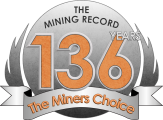Drilling At Buffalo Canyon Intersects Long Runs of Mineralization
Drilling At Buffalo Canyon Intersects Long Runs of Mineralization
RENO, NV – Renaissance Gold Inc. reported assay results from the Buffalo Canyon, Nevada project, which is subject to an earn-in agreement with Kinross Gold, Inc. Five reverse circulation drill holes were completed on the project totaling 5600 feet (1707 m), and were designed to test several targets, both for the lateral and vertical expansion of the mineralization known from prior drilling around the Everson deposit and to explore for higher grade portions of the system.
Drilling at Buffalo Canyon encountered several significant intercepts of gold mineralization as shown in the table below. Holes BCR17-01 and BCR17-02 identified a new zone of gold mineralization along a northwest trending structure at depth below the previously drilled Everson deposit (see attached map). These are the first drill holes to penetrate this structure and opens up potential for significant expansion of the deposit. Hole BCR17-03 drilled through the core of the mineral system with a strong intercept beginning at surface that is representative of the shallow portion of the Everson deposit (79.2 m of 0.35 g/t Au). Both holes BCR17-01 and BCR17-04 validate the presence of long runs of low grade gold mineralization in the gravels to the west and north of the outcropping deposit. These holes are important because they indicate a portion of the deposit has been eroded off. Hole BCR17-05 intercepted gold mineralization within the intrusive complex north of the known system which increases the mineralized footprint considerably, and contained 1.5 m of 5.34 g Au/t, the highest grade intercept in the Everson deposit to date.
Cyanide soluble AA (atomic absorption) analyses on pulps composited over the mineralized intervals are consistent with results reported on previous chip channel samples, and indicate potential for good gold recoveries with cyanide heap leaching. Additional work will explore for higher-grade zones of mineralization which may be preserved under cover, within, or along the margins of the intrusive complex.
Robert Felder, President and CEO states "We are encouraged by the results of this program, indicating significant expansion potential of the known mineralization as well as encountering higher gold grades within thick intervals of the lower grade mineralization." The potential to expand this deposit under cover and potentially drill into the uneroded part of the intrusive could represent a significant breakthrough for the project."




Comments (0)